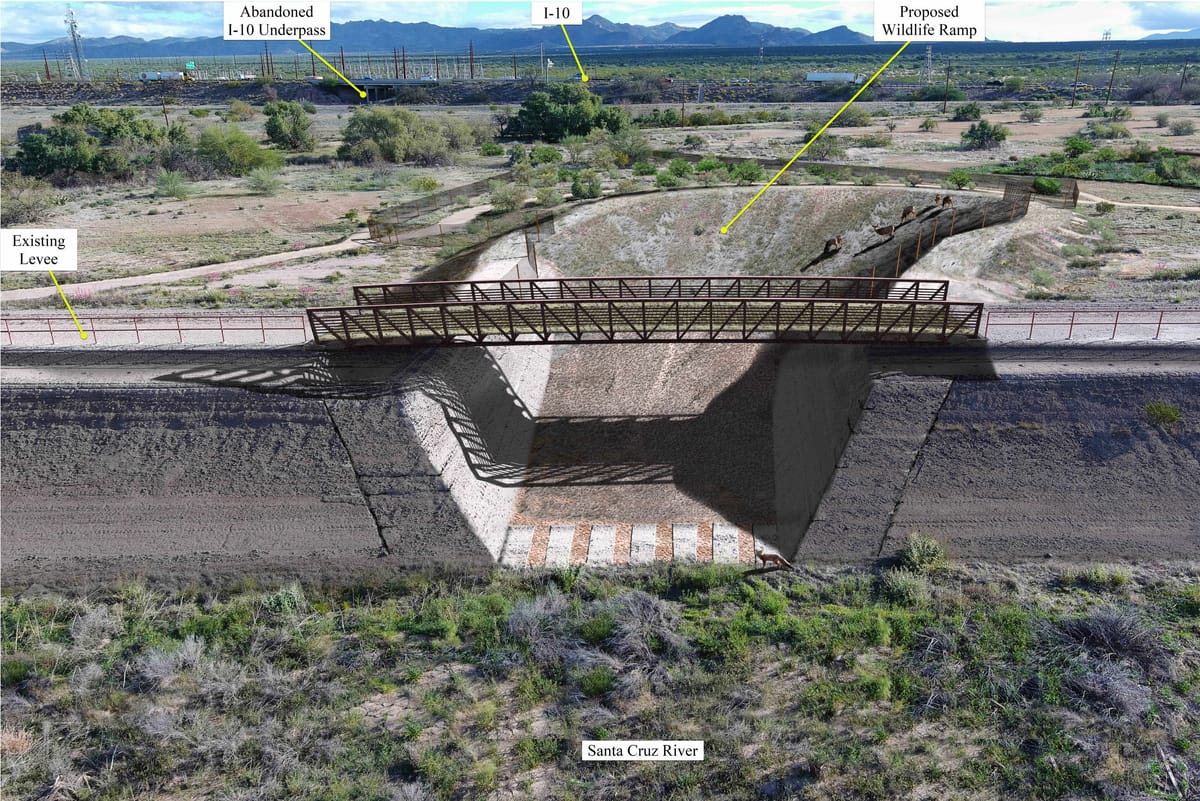Pima County, Tucson officials move forward with wildlife protection plans
Pima County and Tucson officials have taken big steps in recent years to nurture area wildlife and show no signs of slowing down anytime soon.

Officials with the Pima County and the City of Tucson have taken big steps in recent years to nurture area wildlife and show no signs of slowing down anytime soon.
This includes the creation of wildlife corridors and river restoration projects, and ongoing support to expand these efforts.
Pima County supervisors took a significant step last month in a years-long process to build a wildlife crossing at the Santa Cruz River and Avra Valley Road, voting unanimously to amend its Desert Conservation Plan to allow an abandoned railroad trestle to be repurposed as a temporary corridor.
This will keep wildlife safe while the county decides whether the wildlife corridor will go over or under Interstate 10, which runs through the middle of the planned corridor area.
The city is getting in on the action, too. Last week, the Tucson City Council voted unanimously to draft a resolution that would transform the Santa Cruz River into a thriving sanctuary.
The idea is to create a revitalized stretch of river where nature flourishes and community members can gather to bask in the beauty of nature. The initiative not only seeks to restore a vital ecosystem, but also inspire a deep appreciation for conservation and ecological education.
For over 12,000 years, the Santa Cruz River has been a lifeline through Tucson, and used to serve as an important resource for both people and wildlife. But as urbanization swept in, the river's vitality diminished and its waters dwindled.
"After generations of population growth, settler diversions, and groundwater overuse, the perennial surface flows vanished," Vice Mayor Kevin Dahl said during last week’s city council meeting."The river all but dried up, except during heavy seasonal rains.”
Excessive water use has also contributed to depletion of the river and its aquifer, but recent efforts involving recycled water have ignited a resurgence of plant and animal life, signaling a bright path toward healing this precious ecosystem.
In September, Dahl and Council Member Lane Santa Cruz called upon the mayor and council to consider a draft resolution urging Secretary of the Interior Deb Haaland to designate the Santa Cruz River as an urban national wildlife refuge.
"It’s been an example of collaborative governance between our offices, community organizations, and community members who have worked as part of the Coalition to draft this resolution," said Santa Cruz.
Policies designed to rehabilitate natural drainage systems and manage interconnected open spaces will serve as stepping stones toward the refuge's creation. The city envisions a vibrant tapestry of biologically rich habitats, enhanced wildlife corridors, and recreational opportunities that invite residents to connect with nature.
The city has partnered with Tucson Water in its efforts to revitalize the Santa Cruz River, with the utility helping to create and maintain flowing water in sections that previously ran dry.
During a recent interview on the Bill Buckmaster show, Tucson Water Director John Kmiec talked about the two main projects that have been in the works: The Santa Cruz River Heritage Park near downtown, where Tucson Water has been discharging reclaimed water to create a small oasis, and an area near I-19 and Irvington.
The Irvington project uses purified water from the Tucson International Airport Remediation Project to support a riparian habitat, with Kmiec saying both efforts have made a big impact on local wildlife and have become popular spots for bird watching.
“The animals love it,” he said. “The animals love the Tucson Water Customers sharing their waters.”
The new plan to designate the Santa Cruz River as an urban national wildlife refuge provides several benefits, including stronger environmental protection, increased community access, and economic growth.
This would help protect vital open spaces for local wildlife in order to preserve biodiversity. It would also ensure equitable access to the river, creating educational and recreational opportunities for surrounding neighborhoods.
With outdoor recreation and ecotourism generating $11.7 billion in 2022 for Arizona, the refuge could attract nature enthusiasts and birdwatchers, boosting the city's overall appeal. As Kmiec noted, the two project areas have already become a destination for birdwatchers from around the world.
“Community farms with animals, gardens, cattle, and horses dot the Santa Cruz River in the barrios along the river,” said Dahl. “Families still use the channel to work their horses, which are central to a multigenerational culture and traditional way of life."
The proposal has sparked a wave of community support, with local organizations and residents passionately advocating for the refuge's establishment.
The Santa Cruz River Refuge Coalition has dedicated the past two years to engaging the public through workshops, interviews, and petitions, painting a vivid bi-county vision for the future of the river.
Supporters of the initiative say it pays homage to the cultural and spiritual significance of the river for the Tohono O’odham and Pascua Yaqui peoples, who have nurtured these lands for generations. Their connection to the Santa Cruz River serves as a reminder that preserving this ecosystem is essential not only for wildlife but also for honoring cultural heritage.
“There are few elders remaining who remember the river running perennially," said Dahl.
Angelina Maynes is a journalism major at the University of Arizona and reporter with Tucson Spotlight. Contact her at angelinamaynes@arizona.edu.



